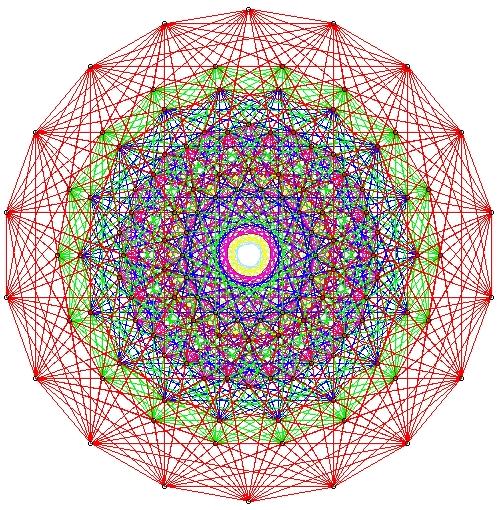
Image by John Stembridge
We have given MathSciNet some upgrades.
As of January 3rd, 2017, MathSciNet will be running on new software, which has allowed us to add some great new features, with more to come in February 2017. This post provides some highlights of how MathSciNet is bigger, better, faster, more.
And please visit the AMS Booth at the JMM in Atlanta to see demonstrations of the new features of MathSciNet, as well as to meet some of the Editors from Mathematical Reviews. There will be free access to MathSciNet at JMM!
Sorting Search Results
Lists of search results will be sortable in a number of different ways, including chronologically, reverse chronologically, and by citations.
Here are the results of a search for publications with Anywhere=(fundamental lemma), sorted three different ways:
Classic sort: Newest First
Oldest First
Sorted by Number of Citations
Attention: Search works differently now
Previously, searches in MathSciNet assumed you were looking for a phrase. Now, searches in MathSciNet insert Boolean AND between terms by default. Thus, the search
will return all items where the word fundamental and the word lemma both occur somewhere. They need not be adjacent.
The search
will search for the phrase fundamental lemma anywhere in our listing of the item. The two words will need to be adjacent to each other.
Here is what the results of the second search, for “fundamental lemma”, look like:
Notice that the number of matches has dropped from 2510 to 512, which is to be expected.
Here are the results sorted by citations:
Refining Search Results
Lists of search results will now include facets that allow users to filter and refine searches. These are the choices listed in the sidebar on the left. The possible refinements here are item type, author, institution, primary classification, journal, and year. Returning to the example just listed (searching for the phrase “fundamental lemma”), we can refine the search by choosing an author:
These matches are based on the author identification (author disambiguation) that goes into creating the Mathematical Reviews author database. (See Who Wrote That? for more on our author identification.) The numbers in parentheses tell how many matches there are: 14 matches for Báo Châu Ngô, 13 for Yuval Z. Flicker, 13 for Jean-Loup Waldspurger, and so on.
Clicking on Laumon, Gérard produces
Notice that the refined results are still sorted by number of citations. The choice of sorting follows along with the refining process.
Related items
In this screen shot, notice that the first two items have a light blue background:
That is because the two items are related. Indeed, they are Parts I and II. We gather them together, even though they were published as two separate books. Indeed, they have one joint review, written by Jonathan David Rogawski.
We can further refine the search by making a choice of Primary Classification.
We see that there are just two choices: Number Theory (MSC=11) with 6 items and Topological groups, Lie groups (MSC=22) with 4 items. Let’s look at the 4 items with primary classification Topological groups, Lie groups:
Notice that the results are still sorted by “Citations”.
Another way to refine these results further is to enter a new search term in the “Search within results” box. This adds the new search term and looks for it anywhere in our record for the item: Author, Title, Journal, Review Text, etc. This example is left as an exercise to the reader…
Displaying the Results of an Author Search
[This section was updated 2017 March 03 to reflect some refinements to Author Searches]
The results of an Author Search now display with more information. Let’s use the Fields Medalist Wendelin Werner as an example, pretending that we don’t remember his first name. Navigating to the Authors tab, we enter “Werner” in the search field.
The results look vastly different now:
There is plenty of extra information to help choose the Werner we were actually looking for. In this case, there are 104 matches. My screen shot only allows us to see the first 12, sorted by Profile Name. Note that the search is looking for “Werner” only as a last name. (An earlier version of New MathSciNet looked in both first name and last name.) By default, the results are listed alphabetically by Profile Name (the name that appears in the Author Profile). We can re-sort by Citations:
There are a few matches with lots of citations. One of them has 1548 citations. We can also see that this Werner started publishing at around the right time to have recently won a Fields Medal. Clicking on Werner, Wendelin brings us to his Author Profile page on MathSciNet
An alternative way to have found Wendelin Werner, assuming we knew something of his mathematics, would have been to refine by Primary Classification. That is to say, to select the classification in which he has published most frequently. In Werner’s case, that is Probability Theory and Stochastic Processes (MSC=60). Note that 6 of these authors have this class as their most frequently occurring MSC.
Selecting Probability Theory and Stochastic Processes yields
Note that, again, the sorting by Citations has followed us as we have refined the search. Wendelin Werner, the Fields Medalist, is still the top result. Clicking on his name leads us again to his Author Profile page
These are just a few highlights of what can be done with the new features of MathSciNet. You can watch a demo video of some of the sorting and faceting improvements. (The video was made when the new features were still prototypes – so some things will look slightly different.) But, the best thing is to try them out — after January 3rd!
More to come
And keep watch for more new features that will come later in 2017:
- Search Result Alerts: Users will be able to log in and create email alerts that will send them any new results for queries that they create. This will allow users to be notified when, for example, an author’s citations count changes, or a new issue is added to a journal.
- Autosuggest for Journals and Author Search Boxes: MathSciNet’s journals and author search boxes will now suggest useful search strings for journal titles and author names.
Thanks
I would be remiss if I didn’t thank Erol Ozil. He is the head of IT at Mathematical Reviews and is the mastermind behind these new features. To begin with, he set the stage for the upgrades by initiating the change in our search software. He then did an amazing job of getting the changes coded in the new environment. As database experts know, this requires restructuring the underlying databases to take advantage of the new code. There were a thousand issues, both large and small, that came up along the way. Erol dealt with them all.
Thank you, Erol.



















Will it now be possible to download all the reviews of an author in one operation?
That is not possible in this version. You have to do it in batches.
More thanks –
Norman Richert, Managing Editor of Mathematical Reviews, has been instrumental in the development of the new features. He has an uncanny sense for the way things should work in MathSciNet. Thank you!
Would it be possible to allow the user of MathSciNet to choose a simpler output, without the new left column? This could be done by an option under “Preferences”. I usually prefer to have most of the screen devoted to the information I am seeking. Thanks in advance.
The ability to revert to the older format is not planned at the moment.
Why the number of citations is suddenly changed (decreased in fact)? It is unclear which citations were removed and why?
At the moment the new version at Providence returns many erroneous results. For example, Author Citation search returns a wrong number of authors that have cited a given author (I have checked that for several different authors). Besides, certain citations that were attributed in the previous version (and still exist at the mirror cites) disappeared, while other citations that were attributed correctly now have wrong attribution. If needed, I can fetch you examples of the discrepancies.
Thank you very much for the new features in MathSciNet. They are very useful and fantastic. Following suggestions may be taken into account:
1. It is better MCQs of journals to be appeared somewhere in front of names of journals in which a certain author published his/her papers (in the Sorted Search Results Column on the left side).
2. When we sort results of an author by citation, it is better the number of citations to be appeared somewhere, e.g., on a column on the right side of the results. I mean here
http://www.ams.org.ezproxy.ir/mathscinet/mrcit/individual.html?mrauthid=324091
3. It is better to see the median and the variance of MCQs of all journals. The average may be not enough and may not give a true face of MCQs. Please add more statistical information in the page http://www.ams.org.ezproxy.ir/mathscinet/mrcit/journal.html?max_citing_year=2015
and for all years.
Furthermore, you may assign Q_i (i=1,2,3,4) for each journal like SJR and JCR lists.
4. When we view publications of a specific author, please allow us to not only “Retrieve First 50” but also “Retrieve All Publications”.
5. It is better to provide a direct link to the ranking of each journal in Scimago: http://www.scimagojr.com/ (and WOS for subscribed institutions and universities) if there is any.
6. Please provide the option of non-selfcitations for counting citations of authors.
7. In the profile of each author, you may provide “Top 100 Highly Cited Articles” to see whether a specific author has such papers.
Best wishes
Are there any plans for AMS to join InCommon (https://www.incommon.org/) and make MathSciNet a SAML Service Provider? This would allow members of subscribing institutions to authenticate via their home institution’s Single Sign On in order to access MathSciNet when off campus. This is standard for online journal access, so it surprises me that the AMS has not taken the same approach.
Thanks.
At the moment, we don’t have such plans. Rather, users can access MathSciNet, as well as AMS journals, by pairing the device with the subscription. See my post about this “Using MathSciNet at home or on the road”
Posted on April 28, 2015
http://blogs.ams.org/beyondreviews/2015/04/28/using-mathscinet-at-home-or-on-the-road/
I have 2 papers in Glasgow Math. J. and one in Glasg. Math. J.
These are of course the same journal.
The facets found in the sidebar of MathSciNet draw information directly from our databases. In the case of the Glasgow Mathematical Journal you mention, the facets are coming from the Journals Database. While editorially, they may be the same journal, from a cataloging point of view, there is a slight difference that we need to keep track of.
You have two papers in
Glasgow Mathematical Journal
Pubisher: Scottish Acad. Press 33 Montgomery St. Edinburgh EH7 5JX Scotland
ISSN: 0017-0895
and one paper in
Glasgow Mathematical Journal
Pubisher: Cambridge Univ. Press The Edinburgh Bldg. Shaftesbury Rd. Cambridge CB2 2RU England
ISSN: 0017-0895
Since the publisher changed, our database has separate listings for them. With the older version of MathSciNet, this distinction was not so apparent. Now, though, we are exposing more of the fine detail of the information about the journals.
We have access to MathSci-Net since a few weeks. I noticed that the proximity search (ADJn; discribed in the help page http://www.ams.org/mathscinet/help/full_search_help_full.html) does not function. Proximity search is so important, that it should be sustained also with the new software version of MathSci-Net.
If you want to use adjacency in searches in new MathSciNet, the form is
“term1 term2″~N
You have to use the double quotes here and there should be no spaces around the tilde. The search will be for exactly term1 and term2 (no singular/plural sloppiness). It will look for items where term1 and term2 are separated by N or fewer other terms. So, if N=2, it would look for term1 term2, term1 stuff term2, and term1 stuff stufff term2. Note, with the old adj trick, adjN would look for matches where there were up to (N-1) terms in between term1 and term2. That is to say, term2 was up to the Nth term from term1.
I really like the upgraded version of MathSciNet and the new features that were added.
However, I noticed a strange issue regarding the number of citations for a given entry.
In many cases the number of citations displayed in the little “Citations” box on the upper right under “From References:” does not equal the number of items returned when clicking on the “From References” link. E.g., using myself as a guinea pig, for MR1981427 (2005m:20080) the “From References:” field says 45, but clicking on that link produces a list of 45 items. On the other hand, for MR2216713 (2007k:20094), “From References:” says 38, but clicking on that link gives a list of 37 items. For MR1757436 (2001c:20098), “From References:” says 16, but clicking on that link gives 17 items. For MR1426902 (98g:20060), “From References:” says 27, while clicking on the “From References” link gives a list of 28 items. Etc. It seems that a discrepancy by 1-2 items is pretty common in this situation. Do you know what causes this discrepancy?
We added a feature that is performing a bit like a bug. There are some linked items in Mathematical Reviews that we refer to as “related papers”. In the print days, we could print the two items right next to each other. However, in the database days, that is not possible. With the new version of MathSciNet, we began linking these papers so that if you found one, you would also find the other. A side effect of this has been that counts can be funny. One number counts with multiplicity; the other does not. Somewhere in the list of papers citing you is probably a pair of related papers. We have already addressed some instances of the counting with multiplicity, and will release a global fix in the near future. See also my blog post on citations.
I am glad that you like the new features.
New version MathSciNet is great.
But,when I click http://www.ams.org/mathscinet/citations.html ,choice Search by Subject or Search by Year or Top 10 Lists ,submit search,havn’t search result .
Thanks for your comment. This is working again.
Hi, I just informed that the the 2015 All Publications MCQ is changed from about 0.39 suddenly to 0.22! May I ask you what happened!
The All Publications MCQ used to be computed only using journal articles. Now it is computed using all items.
Is it possible find authors having the highest number of papers in mathscinet?
It may be possible, but we don’t track that.
Previous under “about SCINET” There was a statement about the number of yearly added items (I recall an estimate of over 100,000 items a year). Can you tell how many were added in 2016? and will you give this info for the coming years? I found it striking and important to know and to make known to the public. Thanks
I don’t remember this being a public number. We report the number to the AMS Board of Trustees each year. For the past nine years, the number has been 100,000 or greater. In 2016, it was roughly 125,000.
Dear colleague,
Since a few months citations (attribute to a given article and whose existence can be observe on other database) do no seems to appear on Mathscinet or only with a very long delay.
As a consequence the total number of citations attribue to a given author appear smaller than it would have been without the recent changes in the system Mathscinet
Do you know at which moment the situation will be back to normal ? Namely the missing citations will appear.
I thank you in advance for your answer.
Best regards. Louis Jeanjean
I don’t recall citations being slow to appear. We add roughly the same number of reference lists each week. There had been some internal backlogs in processing items that might have slowed down their appearing in MathSciNet, but those backlogs have been cleared now. In other words, things should be normal now.
What happened with the DOI field in the Amsrefs citation export?
This was accidental. We have now fixed it.
We changed the code in MathSciNet to account for the https protocol used by doi.org. Unfortunately the code to export citations into amsrefs or bibtex was still looking for http://dx.doi.org to identify and extract the DOI.
Thank you for bringing this to our attention.
Thank you!